
Vol. 14 No. 3 |
Winter 2004-05 |
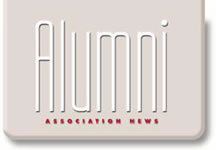 PARTNERING
IN THE PARK
PARTNERING
IN THE PARK
 What do pizza, watermelon, bingo and tae kwon do have in common? They
all came together in late June, along with over 100 guests, at Poplar
Grove Park on Salt Lake City's west side. Families in the neighborhood
were invited to join the U of U Alumni Association and the Sorenson Multicultural
Center at "Partners in the Park," an evening of fun, food and
games; volleyball, basketball and face painting, in particular, proved
popular attractions among the younger set.
What do pizza, watermelon, bingo and tae kwon do have in common? They
all came together in late June, along with over 100 guests, at Poplar
Grove Park on Salt Lake City's west side. Families in the neighborhood
were invited to join the U of U Alumni Association and the Sorenson Multicultural
Center at "Partners in the Park," an evening of fun, food and
games; volleyball, basketball and face painting, in particular, proved
popular attractions among the younger set.
 |
U
of U undergraduates Carmen Medina and Aminatu Yusef coordinated
the Partners in the Park gatherings, thanks to two University Neighborhood
Partners internships provided by the Alumni Association. |
Tae kwon do students ages 7 to 15 from the Sorenson Multicultural Center offered a martial arts demonstration. The event, a University Neighborhood Partners program, was organized jointly by the Alumni Association and the Sorenson Center. The goal of Partners in the Park is to encourage cooperation between University departments and west-side community organizations by having different groups partner to organize an evening of family activities in one of five west-side parks
each Tuesday throughout the summer months.The partnership helps local residents become acquainted with the University of Utah and the educational opportunities it offers for west-side youth, who are statistically under-represented on the U of U campus.
BAY AREA ALUMNI CHAPTER SCHOLARSHIP, 2004-05
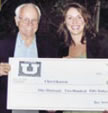 |
| Bay area scholarship recipient Cheryl Karren with chapter president Bob Livsey. |
This year's recipient of the Bay Area scholarship, Cheryl Karren, grew up in a family of devoted Ute supporters. Her father, Ted Karren BS'01, is a U of U graduate, as are two of her uncles. While Ute loyalty is not a scholarship criterion—applicants are judged solely on their academic achievements and community service involvement—having a supportive family cheering you on can't hurt your chances of having a successful U of U experience.
A native of California, Karren first attended Southern Utah University in Cedar City before transferring to the U in 2003 to pursue a degree in business. During her first semester she earned a 3.9 GPA!
Along the way, Karren has been involved in community service activities focused on raising funds for breast cancer education and awareness programs, including the Susan G. Komen Foundation. She has also been active in planning and participating in a "Senior Prom" and other programs for elderly retirement-home patients in Southern Utah.
While at the U, Karren has continued her participation in senior enrichment programs as well as those focusing on children, including the Christmas Box House, which provides temporary shelter for children removed from their homes.
GOING THE EXTRA MILE
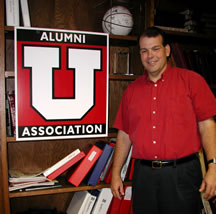 According
to John Fackler BS'89 BS'94 MprA'95, staff supervisor
of the Student Alumni Board (SAB), he has the best job on campus.
According
to John Fackler BS'89 BS'94 MprA'95, staff supervisor
of the Student Alumni Board (SAB), he has the best job on campus.
"It really is a great honor to work with these students," says Fackler. "I see the excitement that the SAB brings to campus and to the Association, and it's nothing short of amazing."
It was that attitude that helped Fackler garner an award for "Outstanding Adviser" from the Association of Student Advancement Programs (ASAP), sponsored by the Council for the Advancement and Support of Education (CASE), at its national convention in Portland, Ore., in August. There were over 100 schools in attendance and only three awards handed out in that category.
SAB member and vice president of external relations Jake Olson says, "I knew John would pull it off. I would have awarded John the Gold Medal years ago. His Olympian efforts to keep SAB going have been the driving force behind a lot of what we do… SAB is the best thing that has happened to me as a Ute, and John has played a big part in that!"
"Of all the organizations I've been involved with on campus, the Student Alumni Board is by far my favorite," says board president Charlotte Tyler, "and John Fackler has a lot to do with that. He has an open-door policy, and students are always walking in and out of his office asking for advice. John supports students' ideas and is always ready for an adventure, whether involving a community service project, a SAB retreat or a football game. John deserves the adviser of the year award!"
The Student Alumni Board plans and participates in various campus programs and events throughout the academic year, including PlazaFest, Homecoming, the annual Utah vs. BYU Food Drive and the year-end "House Party."
MUSS ON THE MOVE
It was on John Fackler's watch that The MUSS was born.
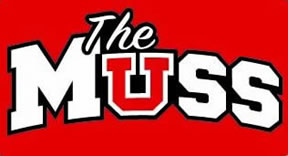 By
now, most U of U students know about The MUSS, the student organization
founded to create unity and excitement around Utah athletics. In a few
short years it has grown into a major player at athletic events. Formerly
called the not-so-catchy University Football Fan Club (UFFC), the MUSS
came into being in 2002, when the SAB was brainstorming for a more memorable
title. A line in "Utah Man" caught member Scott Hammer's eye—
"No other gang of college men dare meet us in the muss" —and
a new name was born. (The group later made the letters into an acronym
for "Mighty Utah Student Section.")
By
now, most U of U students know about The MUSS, the student organization
founded to create unity and excitement around Utah athletics. In a few
short years it has grown into a major player at athletic events. Formerly
called the not-so-catchy University Football Fan Club (UFFC), the MUSS
came into being in 2002, when the SAB was brainstorming for a more memorable
title. A line in "Utah Man" caught member Scott Hammer's eye—
"No other gang of college men dare meet us in the muss" —and
a new name was born. (The group later made the letters into an acronym
for "Mighty Utah Student Section.")
The MUSS now has three separate clubs, for football, basketball and women's gymnastics. Says Charlotte Tyler, SAB president, "[Football] MUSS membership is currently at about 2,700—twice what it was last year, which was twice what it was the year before."
The MUSS is on the move!
UTAH DAY
Something's coming,/Something good/If I can wait/Something's coming/
I don't know/What it is/ But it is/Gonna be great!
Lyrics from"Something's Coming," West Side Story
And so it did.
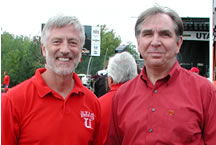 |
| Salt Lake Mayor Rocky Anderson and University of Utah President Michael K. Young. |
In September, Coach Urban Meyer and Salt Lake City Mayor
Rocky Anderson BA'73, an avid Ute fan, launched "Utah Day,"
a three-hour tailgate extravaganza held prior to the Utes' season opener
against Texas A&M.
The Alumni Association partnered in the initiative by agreeing to combine
the (by-now) traditional MUSS pre-game barbecue with Utah Day to create
a mega-event, which was held across the street from Rice-Eccles Stadium.
The gathering featured food and drink vendors, the U of U Marching Band and cheerleaders, and remarks by Mayor Anderson and U of U President Michael Young, who, along with his wife Suzan, were inducted into The MUSS. Introduced by MUSS president Ian White, the Youngs' induction was made official by the donning of bright red MUSS T-shirts. Afterward, live music was provided by the legendary '60s jazz-rock group Blood, Sweat and Tears.
Meyer pronounced Utah Day as "one of the biggest events ever" and "an opportunity to let a secret out that we already know about"—perhaps a reference to the team's potential to reach the national rankings this season?
OPERATION SCHOOL BELL RINGS IN THE 2004-05 SCHOOL YEAR
Operation School Bell "rang" into action again this fall with
dozens of Alumni Association and Assistance League of Salt Lake City volunteers
working to get winter clothing to disadvantaged children in the Salt Lake
Valley. In 2003, the project outfitted more than 5,000 children, and this
year's need looks to be even greater, with the still-struggling American
economy and refugees continuing to pour in from war-torn, disaster-stricken
and economically depressed countries worldwide.
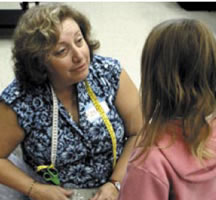 |
| Operation
School Bell chair Kathy Shand BS’72 listens to a young girl
at an outreach event. |
On a rainy early morning in late September, more than 10 volunteers gathered in an elementary school auditorium organizing bags of clothing to help outfit 90-plus children with new coats, sweatshirts and school uniforms, as well as packages of socks, underwear, toothbrushes and toothpaste. Some of the children watched wide-eyed as volunteers pulled item after item out of their bags, asking, "Is that for me, too?"
It is a scene that played out many more times this fall as hundreds more underprivileged American children and new arrivals from countries as far-flung as Somalia and Colombia, Haiti and Bosnia, received what for many would be their one new outfit for the 2004-05 school year.
This year, School Bell will also be increasing its shoe program, doubling its budget to about $10,000. In partnership with Payless Shoe Stores, which sends employees to schools to measure children for fit, OSB will donate about 500-600 pairs of shoes in 2004-05, with giveaways in the fall and again in the spring. A few weeks after the Payless fitting, Assistance League volunteers go back to the schools with the shoes and a new pair of socks for each needy child, donating winter hiking boots in the fall and athletic shoes in the spring.
The Alumni Association became involved with Operation School Bell in 2002. Since then, Association groups including the Student Alumni Board and the Emeritus Board have continued to work eagerly on the project for the immeasurable rewards reaped from aiding such a worthy and satisfying project.
"We are so grateful for the Alumni Association's continued involvement," says Assistance League volunteer Dorothy Ware BA'65.
The Assistance League has led Operation School Bell for more than 20 years, raising some of its funding through sales of clothing and items donated to its thrift shop, located at 2060 E. 3300 South in Salt Lake, and the rest through grants, proceeds from a golf tournament at Hidden Valley Country Club, and community and company donations.
Kathy Shand BS'72, who now chairs Operation School Bell for the Assistance League, says they can always use more hands and more funds. For more information about the project, call Shand at (801) 467-6353.
HOW
WE CAME TO BE "ALUMNI"—IN A MANNER OF SPEAKING
by Marcia C. Dibble
All of us from time to time wax poetic about our alma maters—and for many of us, this very university is our most beloved, and we proudly declare ourselves among its alumni—but how many of us have stopped and thought about the origins of these words and how they came into common usage in English?
The word "university" comes from the Latin word universitas, which means "the whole, the sum total, the universe," and, from the Medieval period on, "a community, society or guild." Thus "university," which entered the English language in about 1300, means both a world unto itself and the whole world—the university is a community, and of the larger world community.
The phrase "alma mater" ("bounteous mother") was originally used by the Romans to refer to any of the many goddesses who bestowed nature's bounty on the populace, such as Ceres (goddess of the harvest). The root of "alma" is the Latin alere, "to nourish," while "mater" means "a cause, origin or source" (making it the root source of both "mother" and "matter"). By 1803, the term alma mater was applied to the university—as a place where one receives intellectual nourishment (intellectual alms)—beginning at Harvard.
"Alumnus"—from the Latin term for "foster child" (one who receives alms) and ultimately also from alere—has been used to mean a student (one who has been entrusted to the care of a school) since 1645.
As far as the alumni/alumnae variations Americans periodically encounter but are largely unfamiliar with, Latin divides word endings into masculine (-us ), feminine (-a), or gender neutral (-um). "Data" is the plural of "datum" ("We collected a wide variety of data"). "Alumni" is the plural form of alumnus; "alumnae" (pronounced like alumni) is the feminine plural. Following the Latin usage, "alumni" is used as the mixed-gender plural.
In American usage, "alumni" has been used since 1843 to mean graduates of a school (a usage also originating at Harvard). The extended usage of the word "alumni" in America most likely derived not only from the desire for graduates to maintain continued communication and affiliation with each other and their alma mater, but from the desire—and need—of American universities to build continued loyalty among graduates in order to sustain themselves, because while European universities have historically been fully government-funded and democratically open to everyone, free of charge, the American system never established this fully federally funded system (and the European system is currently evolving to more closely resemble the American). This extended use of "alumnus" is further illuminated when you understand that the word is also related to "alimony," payment (nourishment) to support an ex-spouse.
Which brings us to the origin of "alumni associations." The first college alumni association was organized at Massachusetts' Williams College in 1821 "during a crisis in the affairs of the college." A group of alumni met in Williamstown and organized the Society of Alumni, "dedicated to the future welfare" of the school. From that very first association, the understood mission of university alumni associations has been to promote and facilitate lifelong relationships between institutions and their former students, nurturing their continued intellectual and social growth, and encouraging their ongoing support of their alma mater—closing the circle by growing the university's onetime beneficiaries into its benefactors.
—Marcia C. Dibble is Continuum assistant editor.